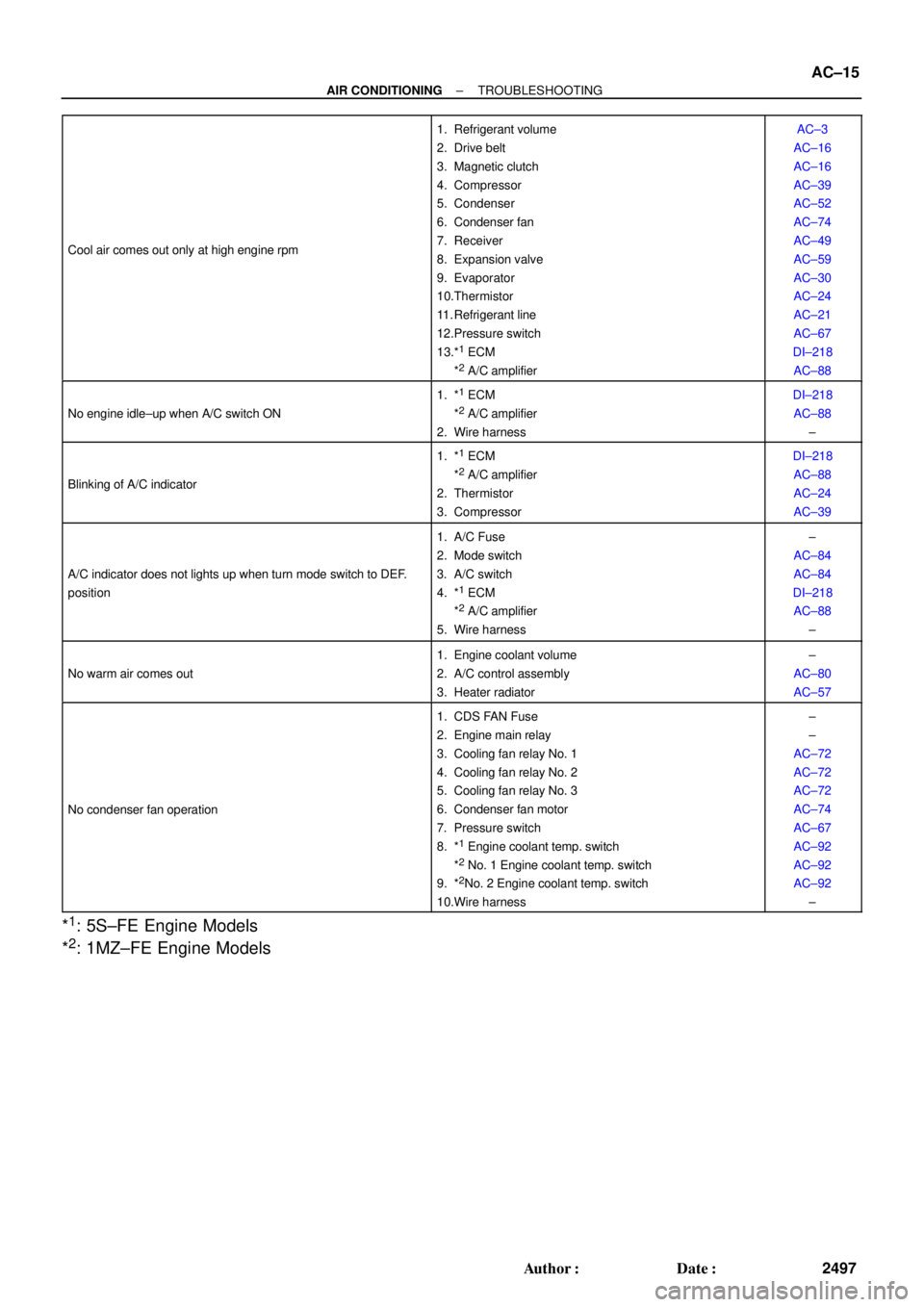Page 9 of 4592

± AIR CONDITIONINGAIR CONDITIONING SYSTEM
AC±9
2491 Author�: Date�:
3. INSPECT IDLE±UP SPEED
(a) Warm up engine.
(b) Inspect idle±up speed when the these conditions are es-
tablished.
�Warm up engine
�Blower speed control switch at ºHIº position
�A/C switch ON
�Temperature control dial at ºCOOLº position
Magnetic clutch conditionIdle±up speed
Magnetic clutch not engaged700 ± 50 rpm
Magnetic clutch engaged700 ± 50 rpm
If idle speed is not as specified, check ISC valve and air intake
system.
4. INSPECT FOR LEAKAGE OF REFRIGERANT
(a) Perform in these conditions:
�Stop engine.
�Secure good ventilation (If not the gas leak detector
may react to volatile gases witch are not refrigerant,
such as evaporated gasoline and exhaust gas.)
�Repeat the test 2 or 3 times.
�Make sure that there is some refrigerant remaining
in the refrigeration system.
When compressor is OFF: approx. 392 ± 588 kPa
(4 ± 6 kgf/ cm
2, 57 ± 85 psi)
(b) Bring the gas leak detector close to the drain hose before
performing the test.
HINT:
�After the blower motor stopped, leave the cooling unit for
more than 15 minutes.
�Expose the gas leak detector sensor the under the drain
hose.
�When bring the gas leak detector close to the drain hose,
make sure that the gas leak detector does not react to the
volatile gases.
If such reaction is unavoidable, the vehicle must be lifted up.
(c) If gas leak is not detected on the drain hose, remove the
blower resistor from the cooling unit. Then insert the gas
leak detector sensor into the unit and perform the test.
(d) Disconnect the connector and leave the pressure switch
for approx. 20 minutes. Then bring the gas leak detector
close to the pressure switch and perform the test.
(e) Bring the gas leak detector close to the refrigerant lines
and perform the test.
Page 15 of 4592

± AIR CONDITIONINGTROUBLESHOOTING
AC±15
2497 Author�: Date�:
Cool air comes out only at high engine rpm
1. Refrigerant volume
2. Drive belt
3. Magnetic clutch
4. Compressor
5. Condenser
6. Condenser fan
7. Receiver
8. Expansion valve
9. Evaporator
10.Thermistor
11. Refrigerant line
12.Pressure switch
13.*
1 ECM
*2 A/C amplifier
AC±3
AC±16
AC±16
AC±39
AC±52
AC±74
AC±49
AC±59
AC±30
AC±24
AC±21
AC±67
DI±218
AC±88
No engine idle±up when A/C switch ON
1. *1 ECM
*2 A/C amplifier
2. Wire harness
DI±218
AC±88
±
Blinking of A/C indicator
1. *1 ECM
*2 A/C amplifier
2. Thermistor
3. Compressor
DI±218
AC±88
AC±24
AC±39
A/C indicator does not lights up when turn mode switch to DEF.
position
1. A/C Fuse
2. Mode switch
3. A/C switch
4. *
1 ECM
*2 A/C amplifier
5. Wire harness
±
AC±84
AC±84
DI±218
AC±88
±
No warm air comes out
1. Engine coolant volume
2. A/C control assembly
3. Heater radiator±
AC±80
AC±57
No condenser fan operation
1. CDS FAN Fuse
2. Engine main relay
3. Cooling fan relay No. 1
4. Cooling fan relay No. 2
5. Cooling fan relay No. 3
6. Condenser fan motor
7. Pressure switch
8. *
1 Engine coolant temp. switch
*2 No. 1 Engine coolant temp. switch
9. *2No. 2 Engine coolant temp. switch
10.Wire harness
±
±
AC±72
AC±72
AC±72
AC±74
AC±67
AC±92
AC±92
AC±92
±
*1: 5S±FE Engine Models
*
2: 1MZ±FE Engine Models
Page 958 of 4592
BO0NA±01
H01874
Headrest SupportHeadrest
Seatback Frame
Seatback Pad
Seatback Cover
RH Seatback
Hinge
Center Seatback Hinge
Rear Seat center
Armrest
Center Armrest
Hinge Cover
LH Seatback Hinge
Seat Cushion Cover
Seat Cushion Pad Seatback Locking Knob
Seatback Lock Knob Gromet
Rear Seatback Lock Control
Rear Seatback lock
Control Bezel Seatback Lock control Cable
: Specified torque
N´m (kgf´cm, ft´lbf)
RH Rear Side
Seatback
LH Rear Side
Seatback
18 (185, 13)
18 (185, 13)
18 (185, 13)
17.5 (178, 12.5)
18 (185, 13)
Seat Belt Guide
± BODYREAR SEAT (TMC Made)
BO±113
2461 Author�: Date�:
REAR SEAT (TMC Made)
COMPONENTS
Page 960 of 4592
BO0NC±01
± BODYREAR SEAT (TMC Made)
BO±115
2463 Author�: Date�:
DISASSEMBLY
1. REMOVE SEAT CUSHION COVER
Remove the hog rings and seat cushion cover from the seat cushion pad.
2. REMOVE THESE PARTS:
HINT:
Remove the clips to turn over the seatback cover before performing the following steps.
(a) Headrest
(b) Rear seatback lock control Bezel.
(c) Rear seatback Board
(d) Headrest supports
(e) Seatback locking knob
(f) Seatback lock knob Gromet
(g) Rear seat center armrest
3. REMOVE SEATBACK COVER
(a) Remove the hog rings and seatback frame from the seatback cover with pad.
(b) Remove the hog rings and seatback cover from the seatback pad.
4. REMOVE SEATBACK LOCK
(a) Remove the rear seatback lock control cable.
(b) Remove the 2 bolts and rear seatback lock control.
Torque: 17.5 N´m (178 kgf´cm, 12.5 ft´lbf)
Page 963 of 4592
BO0N5±01
H01875
Rear seatback Board
Rear Seatback frame
RH Rear Side
SeatbackRear Seatback CoverRear Seatback PadHeadrest
Support
LH Seatback Hinge Seatback Lock Knob
Seatback Lock Knob
Cover
Rear Seatback Lock
Control Cable
Rear Seatback
Control Bezel
Seat Cushion Cover LH Side Seatback Headrest
Headrest Suppot
Seatback Pad
Seatback Cover
Seat Cushion Pad
Child Restraint Seat Headrest
Rear Seatback Lock
Control
Center Seatback
Hinge
Center Seatback
Hinge
: Specified torque
N´m (kgf´cm, ft´lbf)
RH Seatback Hinge
Rear Seat center
Armrest
18 (185, 13)18 (185, 13)
18 (185, 13)Center Armrest
Hinge Cover18 (185, 13)
18 (185, 13)
7.8 (79, 69 in.´lbf)
42 (428, 31)
13 (130, 9)
17.5 (178, 12.5)
Child Restraint
Seat Coverw/ CRS: BO±118
± BODYREAR SEAT (TMMK Made)
2466 Author�: Date�:
REAR SEAT (TMMK Made)
COMPONENTS
Page 965 of 4592
BO0N7±01
BO±120
± BODYREAR SEAT (TMMK Made)
2468 Author�: Date�:
DISASSEMBLY
1. REMOVE SEAT CUSHION COVER
Remove the hog rings and seat cushion cover from the seat cushion pad.
2. REMOVE THESE PARTS:
HINT:
Remove the clips to turn over the seatback cover before performing the following steps.
(a) Headrest
(b) Rear seatback control Bezel
(c) Headrest supports
(d) Seatback lock knob
(e) Seatback lock knob cover
(f) Rear seat center armrest
3. REMOVE SEATBACK COVER
(a) Remove the hog rings and seatback frame from the seatback cover with pad.
(b) Remove the hog rings and seatback cover from the satback pad.
4. REMOVE SEATBACK LOCK
(a) Remove the rear seatback lock control cable.
(b) Remove the 2 bolts and rear seatback lock control.
Torque: 17.5 N´m (178 kgf´cm, 12.5 ft´lbf)
Page 1214 of 4592

DI00G±05
ENGINE CONTROL SYSTEM Check Sheet
Customer's Name
Driver's Name
Data Vehicle
Brought in
License No.
Model and Model
Year
Frame No.
Engine Model
Odometer Reading
Problem Symptoms
Engine does
not Start
Difficult to
Start
Poor Idling
Poor
Driveaability
Engine Stall
Others
Engine does not crankNo initial combustionNo complete combustion
Engine cranks slowly
Other
Incorrect first idleIdling rpm is abnormalHigh ( rpm)Low ( rpm)
Rough idling
Other
HesitationBack fireMuffler explosion (after±fire)Surging
Knocking
Other
Soon after startingAfter accelerator pedal depressed
After accelerator pedal released
During A/C operation
Shifting from N to D
Other
Datas Problem
Occurred
Problem Frequency
Condition When
Problem Occurs
Weather
Engine Operation
Engine Temperature Place Outdoor
TemperatureConstant
Sometimes ( times per day/month)Once only
Other
Fine
CloudyRainySnowyVarious/Other
Hot
Warm CoolCold (approx. °F/ °C)
Highway
SuburbsInner cityUphillDownhill
Rough road
Other
Cold
Warming upAfter warming upAny temperatureOther
Starting
Just after starting ( min.)IdlingRacing
Driving
Constant speedAccelerationDeceleration
A/C switch ON/OFF
Other
Condition of MILRemains on Sometimes light up Does not light up
NormalMalfunction code(s) (code )
Freezed frame data ( )
NormalMalfunction code(s) (code )
Freezed frame data ( )
Normal Mode
(Precheck)
Check Mode DTC InspectionInspector's
Name
km
miles
DI±2
± DIAGNOSTICSENGINE (5S±FE)
237 Author�: Date�:
CUSTOMER PROBLEM ANALYSIS CHECK
Page 1227 of 4592

± DIAGNOSTICSENGINE (5S±FE)
DI±15
250 Author�: Date�:
(b) TOYOTA Enhanced Signals.
TOYOTA hand±held tester displayMeasurement ItemNormal Condition*1
MISFIRE RPMEngine RPM for first misfire rangeMisfire 0: 0 rpm
MISFIRE LOADEngine load for first misfire rangeMisfire 0: 0 g/r
INJECTORFuel injection time for cylinder No.1Idling: 2.9 ~ 5.1 ms
IAC DUTY RATIOIntake Air Control Valve Duty Ratio
Opening ratio rotary solenoid type IAC valveIdling: 25 ~ 62 %
STARTER SIGStarter SignalCranking: ON
CTP SIGClosed Throttle Position SignalThrottle fully closed: ON
A/C SIGA/C Switch SignalA/C ON: ON
PNP SIGPark/Neutral Position Switch SignalP or N position: ON
ELECTCL LOAD SIGElectrical Load SignalDefogger S/W ON: ON
STOP LIGHT SWStop Light Switch SignalStop light switch ON: ON
PS OIL PRESS SWPower Steering Oil Pressure Switch SignalTurn steering wheel: ON
FC IDLFuel Cut Idle: Fuel cut when throttle valve fully
closed, during decelerationFuel cut operating: ON
FC TAUFuel Cut TAU: Fuel cut during very light loadFuel cut operating: ON
CYL#1, CYL#2, CYL#3, CYL#4Abnormal revolution variation for each cylinder0 %
IGNITIONTotal number of ignition for every 1,000 revolu-
tions0 ~ 2,000 rpm
EGR SYSTEMEGR system operating conditionIdling: OFF
FUEL PUMPFuel Pump SignalIdling: ON
A/C CUT SIGA/C Cut SignalA/C S/W OFF: ON
A/C MAG CLUTCHA/C Switch SignalA/C ON: ON
EVAP (PURGE) VSVEVAP VSV SignalVSV operating: Avove 30 %
VAPOR PRESS VSVVapor Pressure VSV SignalVSV operating: ON
TOTAL FT B1Total Fuel Trim Bank 1: Average value for fuel
trim system of bank 1Idling: 0.8 ~ 1.2 V
O2 LR B1, S1 *2
Heated Oxygen Sensor Lean Rich Bank 1 Sen-
sor 1: Response time for oxygen sensor output to
switch from lean to rich
Idling after warming up: 0 ~ 1,000 msec.
O2 RL B1, S1 *2
Heated Oxygen Sensor Rich Lean Bank 1 Sen-
sor 1: Response time for oxygen sensor output to
switch from rich to lean
Idling after warming up: 0 ~ 1,000 msec.
*1: If no conditions are specifically stated for ºldlingº, it means the shift lever is at N or P position, the A/C
switch is OFF and all accessory switches are OFF.
*2: Except California Specification vehicles.